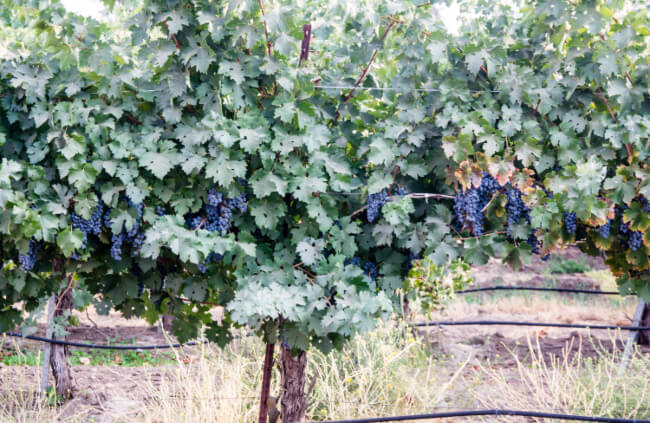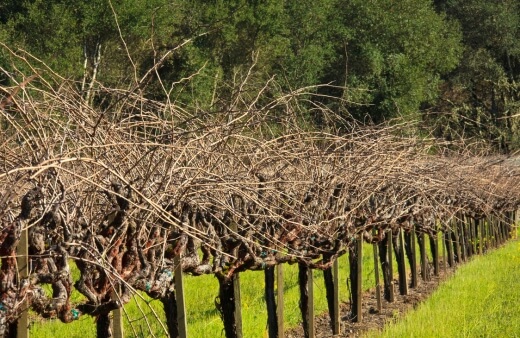Let me ask you a question before we start. Why do you want to grow grapes? Are you after a good eating grape that you can pluck straight from the vine? Or, are you hoping to grow grapes to make wine from the juice?
Or, are you hoping to cover an arbour, pergola or patio with a climbing vine that produces a fruit as well? Maybe, it’s all three.
More...
Is it possible to have all three? Yes, but it’s no easy task and you may have to compromise on one of the choices to better appreciate one of the others. For instance, most good wine growing grapes aren’t great tasting.
They’re usually very acidic and can taste tart or sour. Good table grapes, on the other hand, usually make poor wine and if you’re primarily after a climber that will cover your pergola quickly then you may need to compromise again on the other two.
The beauty of growing a grape vine is that they take only a small amount of space to grow and can still produce more than enough for your family needs.

How to Plant and Grow Grapevines
If you’ve picked up a potted vine from a nursery or from a friend’s collection then it’s a simple process but may require some physical labour. Here are the steps involved;
- Find an appropriate site to plant your vine. Grape vines appreciate full-sun and a loamy, even gravelly, rich soil.
- Construct a support that will be able to hold the weight of a mature vine and its fruit in season. This may be a trellis growing alongside a wall or self-standing as you would see in a vineyard. You may decide to grow it over an arbour or even a pergola. Whatever the structure, it’s important that it will last the distance of supporting the vine for many years.
- Once you’ve found the site and you have an appropriate structure in place it’s time to plant the vine. This is no different to planting many plants but you may like to further enrich the soil with more compost and slow-release fertilisers.
Grapes rely heavily on water so ensure that some reticulation is available or keep the water up to the vine especially when you’ve first planted it and also while it’s fruiting.
How to Propagate Grapevines
Propagating grape vines is very easy. As you are pruning your vine in the middle of winter, cut some of the hardwood canes in lengths that include 2 bud nodes (one at either end).
It is a good technique for remembering which way is up and which down by cutting the vine below a base node (the one closest to the trunk) horizontally and the cut above the second node (the one closest to the tip of the vine cane) at an angle.
In a 200 mm pot, or you can plant directly into soil in a sheltered spot, place a few canes in some good quality potting mix. Water well and then cover with some plastic and wait for the top bud to burst open.
Once this has happened you might need to wait a month or two before planting each cane out in its own pot. They should have grown their own root ball by this stage and showing signs of vigorous vine growth.
Australian Guide to Pruning Grapevines
Grape plants are vigorous growers and very forgiving plants, which is why they are an alluring challenge, even for first-time growers—however, proper care and maintenance of grapevines is essential in avoiding a tangled mess.
Grapevines, when left uncontrolled, can grow tremendously quickly, and if left to tangle, will result in a lack of crop in the following season. So, how does one make sure they are pruning their grapevines correctly and effectively? Here is our in-depth guide on pruning grapevines.

When you buy your first grapevine plant, you’ll quickly notice lots of bare shoots. When planting in the springtime, you’ll want to cut back any surplus shoots and leave one firm, established shoot behind.


Get Your Free Guide:
Master Growing Australian Natives eBook
A Must Have Complete Guide for Every Australian Garden
Get Your Free Guide:
Master Growing Australian Natives eBook
A Must Have Complete Guide for Every Australian Garden
Choose the most vigorous looking shoot and stake it to help support it. Another option is to tie to a fence or wire. The most crucial factor is that the main shoot is supported. Look for a shoot that is already beginning to grow upright. This will become your base trunk.
All other shoots can then be removed, either by hand or with a sterilised set of pruning shears. As the main trunk begins to grow, it will then grow new fresh, fruit-bearing shoots. In the first dormant season, these will then need to prune back.
Why is Pruning Grapevines Important?
Regular and rigorous pruning is essential for grapevines, not only for control but also to ensure fruit quality. Along with pruning, grapevines need to be trained to grow in specific systems that allow each shoot to receive enough sunlight and enough space to bear fruit.
Luckily grape vines are easily manipulated and, once trained, will continue to grow in the correct manner for optimal yield.
When Should Grapevines Be Pruned?
Regular maintenance and training of grapevines can occur throughout the year. However, proper pruning of the plant should only be done during its dormant season, ideally in early winter.
Your grapevine must have a solid, established base trunk, and pruning should be avoided until the main trunk is at least 76 cm in height. Shoots should also only be pruned once they have reached anywhere between 20 to 30 cm.
During the summer months, shoots can begin to be trained by gently bending them in the right direction. More so, if you notice shoots starting to grow at the lower parts of the trunk, you can prune these down even in summer.

How to Prune Grape Vines at Home?
When it comes to pruning, knowing how to do it can make all the difference when it comes to yielding crops. Incorrectly pruned grapevines or too lightly pruned grapevines will often produce poor quality and low quantity crops.
As a rule of thumb, never be afraid to prune back too much. Do not be scared to cut back lots of old wood. Your grapevines will bounce back, and it will mean lots of new, fruit-bearing shoots.
It is crucial to only cut back shoots that are growing from the main trunk. Avoid cutting back shoots that grow out from the soil in the first few years, as this can damage the root system.
Pruning in Your Grapevines' First Dormancy
The first prune is very important and should only be done if your main trunk is at least 76 cm in height. Your grapevines will need a sturdy base to grow out from. If your trunk hasn’t reached this height, you can cut the three buds and repeat the initial routine for another year.
Different Ways to Pruning Grapevines
The Kniffen Method
There are different ways that growers decide to prune their grapevines, and this will often depend on what kind of grapes you are growing. For grapevines that don’t require winter protection, the 4-arm Kniffen method is preferred.
As part of this method, grower’s will use two horizontal wires to support four main growing vines. The first wire should sit at about 1 metre from the ground, the other at about 1.5 metre.
You can then leave the vines to grow along the wires and prune back any vines which are not increasing along the wires.
The Cordon System
Another method that is successful for grapevines is the Cordon system. This entails training one healthy vine on either side of the main trunk. These become permanent vines that will bear all of the fruit.
Often, these main vines will need to be pruned back slightly when they become too old or too long.

Pruning Grapevines that Need Winter Protection
Some types of grapevines will require winter protection, which means that pruning will be slightly more tricky. With these kinds of grapevines, it is best to prune the entire plant back to one horizontal trunk every year.
You can prune back as much as .9 to 1.2 metres each time, leaving at least one two-bud renewal spur.
Canopy Management Year-Round
Maintaining your grapevines year-round is essential as they grow incredibly quickly, and not every single shoot will bear fruit. In general, any shoots that grow along the lower part of the main trunk can be cut back immediately, even in summer.
Any unproductive shoots should be pruned back during the dormant season. Often, when shoots become crowded, not enough light reaches those shoots that may bear fruit. In these instances, it will result in a lack of crop.
Shoots should be spaced at least 7.5 to 10 cm apart. Shoots with fruit clusters should be kept. However, there should only be one fruit cluster per shoot.
Quick Final Tips for Grapevine Pruning
Whichever method you decide to use, always be sure to:
- Inspect your plant before pruning. It’s always a good idea to look at how your grapevine is growing and which shoots appear to be growing best.
- Keep the Strongest Shoots. Identify exactly which shoots you want to keep, either because they look strong or are already developing fruit clusters.
- Keep One Fail-Safe Shoot. Shoots can accidentally break during pruning, so always keep one semi-decent looking shoot right until the end, in case.
Remove anything that looks small or weak. Any shoots that look frail or aren’t the width of your pinky finger can be removed.

Wrapping Up Our Guide to Pruning Grapevines
So, there you have it—everything you need to know to keep your grapevines happy and bearing the most beautiful fruit. Again, never be afraid to cut back too much. Grapevines are incredibly resilient, and there is not something as too much.
When pruning, you can use your hands. However, a sterilised pair of pruning shears is preferable as you will have more control and be more protective against the spread of disease while pruning grapevines.
Published on April 16, 2023 by Gary Clarke
Last Updated on October 1, 2025




